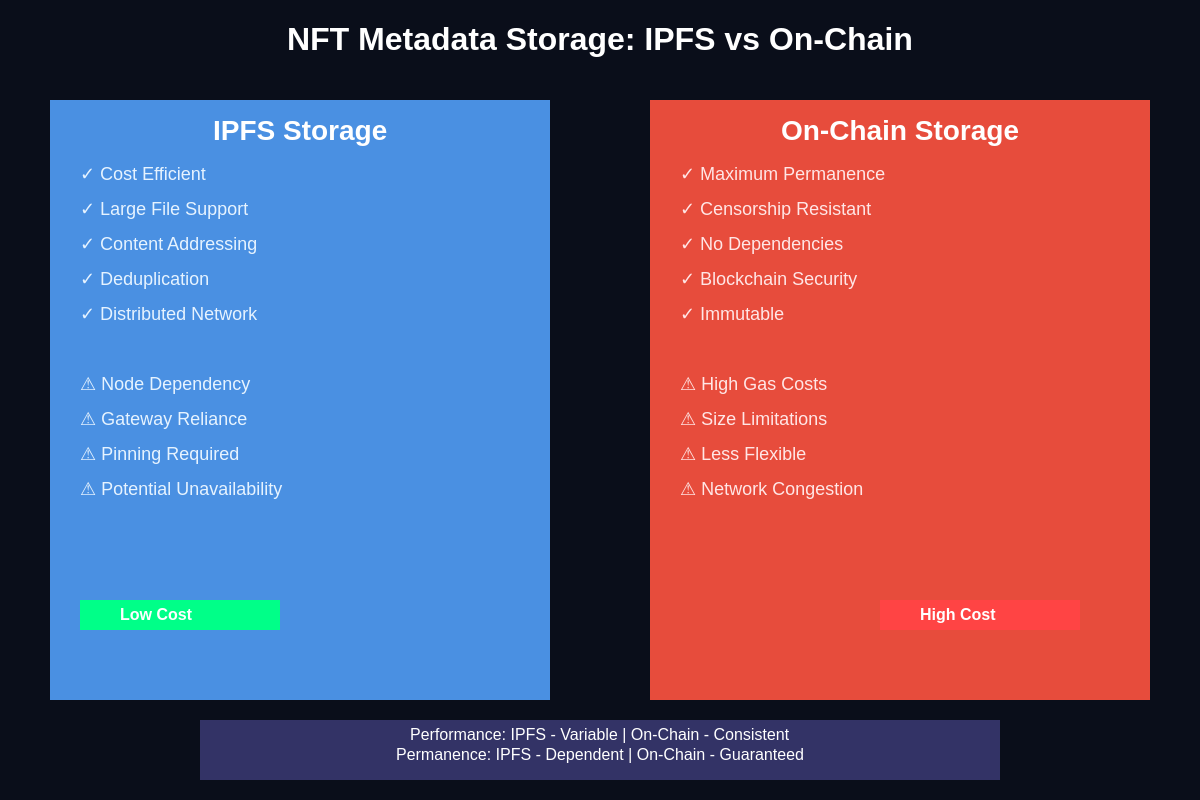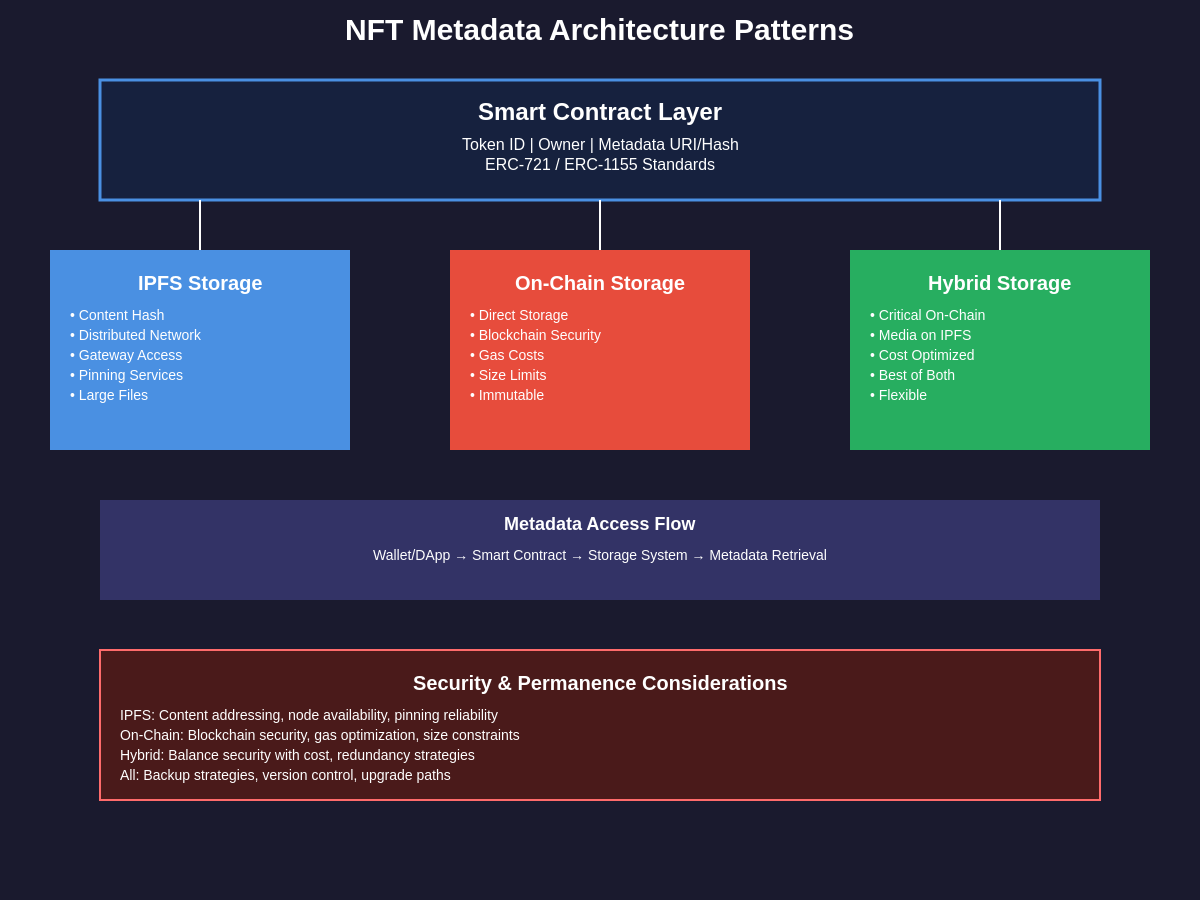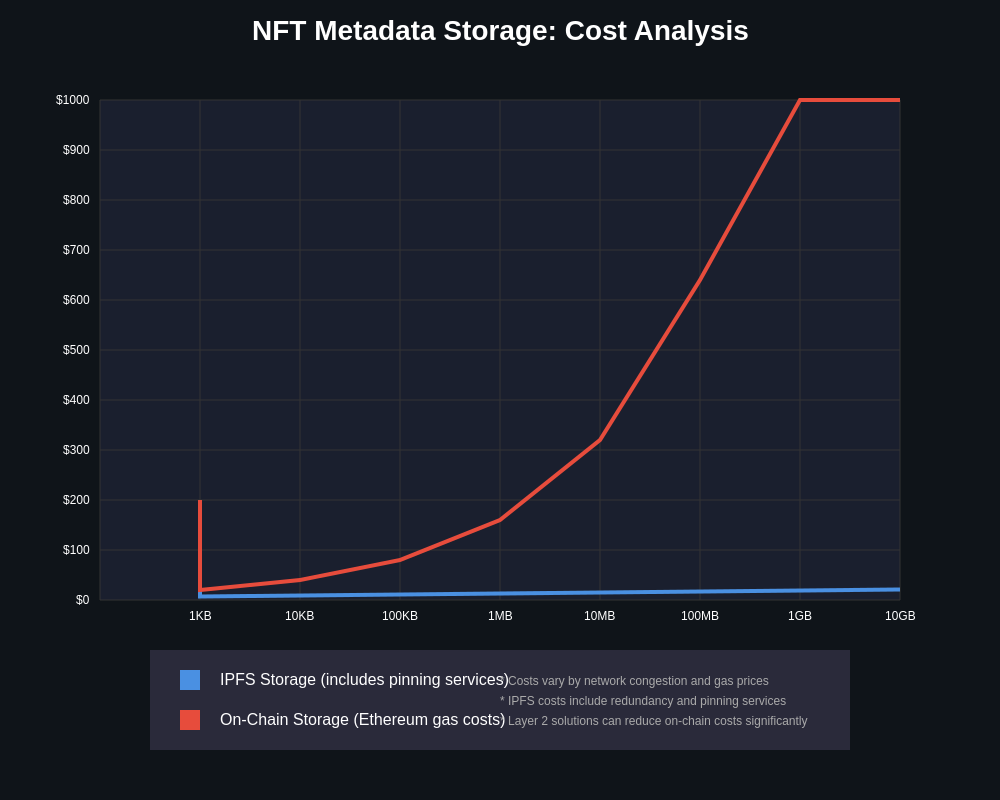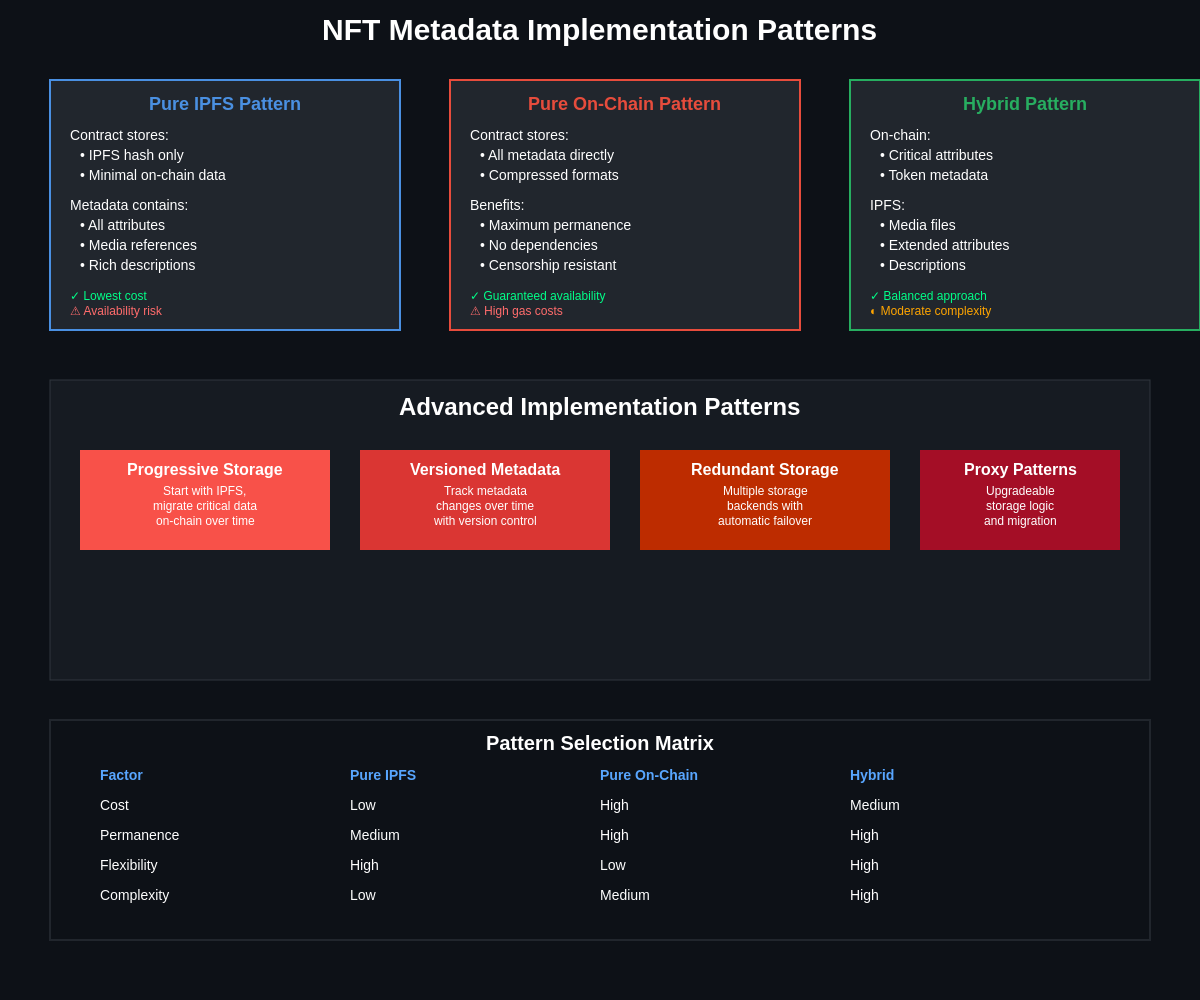The fundamental architecture of Non-Fungible Token (NFT) metadata storage has emerged as one of the most critical technical debates in the blockchain ecosystem, with profound implications for permanence, decentralization, cost efficiency, and user experience. As the NFT market has matured beyond simple profile pictures to encompass complex multimedia assets, gaming items, digital real estate, and enterprise applications, the choice between InterPlanetary File System (IPFS) storage and on-chain storage has become increasingly consequential for creators, collectors, and platforms alike.
The TradingView platform provides comprehensive tracking of NFT market performance, revealing how metadata storage decisions directly impact collection valuations and long-term sustainability. This technical debate extends beyond mere storage preferences to encompass fundamental questions about blockchain philosophy, economic sustainability, and the future of digital ownership in decentralized systems.
The evolution of NFT metadata standards reflects the broader maturation of blockchain technology, with early implementations prioritizing simplicity and cost efficiency while more recent approaches emphasize permanence, decentralization, and resistance to censorship. Understanding the technical trade-offs between IPFS and on-chain storage requires examination of consensus mechanisms, economic incentives, network effects, and long-term sustainability considerations that extend far beyond immediate technical implementation details.
Understanding NFT Metadata Architecture
NFT metadata represents the essential information that defines a non-fungible token beyond its basic ownership record, including attributes such as name, description, image references, properties, traits, and multimedia content that give the token its unique characteristics and value proposition. The architecture of how this metadata is stored, accessed, and maintained fundamentally determines the long-term viability, accessibility, and authenticity of NFT collections.

Traditional NFT implementations typically store only a minimal amount of information on-chain, primarily the token identifier and a reference pointer to external metadata, which may be hosted on centralized servers, IPFS networks, or fully stored on the blockchain itself. This architectural decision represents a critical trade-off between cost efficiency, performance, decentralization, and permanence that has far-reaching implications for token utility and long-term value preservation.
The metadata structure itself has evolved significantly since the early days of NFTs, with standards like ERC-721 and ERC-1155 providing foundational frameworks while newer approaches incorporate more sophisticated data schemas, multimedia support, and dynamic attributes that can change over time. Understanding these architectural foundations is essential for evaluating the relative merits of different storage approaches and their implications for various use cases.
Smart contract implementations must carefully balance the amount of data stored directly on-chain versus referenced externally, with decisions affecting not only immediate deployment costs but also long-term accessibility, user experience, and resistance to censorship or data loss. The gas costs associated with storing large amounts of data on Ethereum and other blockchain networks have historically driven most implementations toward hybrid approaches that store critical identifiers on-chain while maintaining larger metadata sets through external references.
IPFS Storage Advantages and Implementation
The InterPlanetary File System represents a distributed, content-addressed storage network that offers significant advantages for NFT metadata storage, including built-in deduplication, cryptographic verification of content integrity, and a decentralized architecture that reduces dependence on any single point of failure. IPFS addresses content through cryptographic hashes rather than location-based URLs, ensuring that metadata references remain valid regardless of where the actual data is stored within the network.

Content addressing through IPFS provides inherent tamper resistance, as any modification to stored metadata would result in a different hash, making unauthorized changes immediately detectable and breaking the reference chain from the NFT contract. This cryptographic integrity protection offers stronger guarantees than traditional URL-based references while maintaining the flexibility to store large multimedia files, complex metadata structures, and rich attribute sets without prohibitive on-chain storage costs.
The distributed nature of IPFS means that popular NFT metadata can be replicated across multiple nodes globally, improving access performance and redundancy while reducing the risk of data loss compared to centralized storage solutions. However, the IPFS network relies on voluntary node participation and pinning services to maintain content availability, creating potential challenges for long-term accessibility if content is not adequately replicated or maintained by network participants.
IPFS implementation for NFT metadata typically involves uploading content to the network, obtaining the resulting content hash, and storing this hash reference in the NFT smart contract, either directly or through gateway URLs that provide HTTP access to IPFS content. The market data available on TradingView shows that projects utilizing IPFS storage often achieve better long-term price stability due to reduced concerns about metadata permanence.
Performance considerations for IPFS-based NFT metadata include initial content propagation delays, potential gateway accessibility issues, and the need for reliable pinning services to ensure long-term availability. Many successful NFT projects implement hybrid approaches that use IPFS for primary metadata storage while maintaining backup systems and multiple gateway providers to ensure consistent accessibility for users and applications.
On-Chain Storage Benefits and Challenges
Storing NFT metadata directly on-chain provides the highest level of permanence, decentralization, and censorship resistance, ensuring that as long as the blockchain network continues to operate, the metadata will remain accessible without dependence on external systems, pinning services, or third-party infrastructure providers. This approach aligns with the philosophical principles of blockchain technology by maintaining complete self-sufficiency and eliminating potential points of failure associated with external storage dependencies.
On-chain storage eliminates the risks associated with IPFS node availability, pinning service reliability, and gateway accessibility issues that can potentially make IPFS-stored metadata temporarily or permanently inaccessible. The data becomes as permanent and immutable as the blockchain itself, providing collectors and creators with absolute certainty about long-term accessibility and preservation of their digital assets.
The primary challenge of on-chain metadata storage lies in the significant cost implications, particularly on networks like Ethereum where gas fees for data storage can make comprehensive metadata storage prohibitively expensive for complex NFT collections. Current gas price tracking on TradingView demonstrates how network congestion directly impacts the feasibility of on-chain storage approaches for cost-sensitive applications.
Smart contract size limitations present additional technical challenges for on-chain metadata storage, as blockchain networks typically impose limits on contract size and transaction complexity that can restrict the amount of metadata that can be stored directly within NFT contracts. These limitations require careful optimization of data structures, compression techniques, and efficient encoding methods to maximize the metadata that can be stored within technical constraints.
On-chain metadata storage also presents challenges for dynamic or evolving NFT properties, as blockchain immutability makes it difficult to update metadata after deployment without implementing complex proxy patterns or migration mechanisms. This trade-off between permanence and flexibility requires careful consideration during the design phase of NFT projects, particularly those involving gaming assets, evolving digital art, or other use cases where metadata may need to change over time.
Cost Analysis and Economic Considerations
The economic implications of NFT metadata storage decisions extend far beyond initial deployment costs to encompass long-term maintenance expenses, scalability constraints, and the broader economic sustainability of different storage approaches. Comprehensive cost analysis must consider not only immediate gas fees for on-chain storage but also ongoing IPFS pinning costs, gateway maintenance expenses, and the potential economic impact of metadata unavailability on NFT valuations.

On-chain storage costs vary dramatically across different blockchain networks, with Ethereum representing the most expensive option while layer-2 solutions, alternative blockchains, and specialized NFT-focused networks offering significantly lower costs for comprehensive metadata storage. The choice of blockchain network can dramatically affect the feasibility of different storage approaches, with some networks specifically designed to accommodate rich on-chain metadata at reasonable costs.
IPFS storage costs primarily involve pinning services that ensure content remains available within the network, with prices varying based on storage duration, bandwidth requirements, and redundancy levels. Popular pinning services offer various pricing tiers that can make IPFS storage economically attractive for projects requiring large multimedia files or extensive metadata sets that would be prohibitively expensive to store on-chain.
The cryptocurrency market analysis tools on TradingView reveal significant correlations between metadata storage approaches and long-term NFT collection performance, with projects implementing robust storage solutions generally maintaining better price stability and collector confidence over time.
Economic sustainability of different storage approaches must also consider the network effects and incentive structures that support long-term availability, with on-chain storage benefiting from the economic incentives that secure blockchain networks while IPFS relies on the continued participation of voluntary nodes and commercial pinning services that may face different economic pressures over time.
The total cost of ownership for NFT metadata storage includes not only initial deployment and storage costs but also ongoing monitoring, maintenance, backup, and potential migration expenses that can accumulate significantly over the lifetime of an NFT collection. Projects must carefully evaluate these long-term economic implications when selecting storage architectures, particularly for collections intended to maintain value and accessibility over extended periods.
Technical Implementation Patterns
Modern NFT implementations increasingly adopt hybrid approaches that combine the benefits of both IPFS and on-chain storage through sophisticated technical patterns designed to optimize cost, performance, permanence, and user experience. These patterns typically involve storing critical identifying information and compact metadata on-chain while maintaining larger assets and extended metadata through IPFS references.

Progressive storage strategies represent one popular implementation pattern where essential metadata is stored on-chain during minting, with additional attributes, multimedia content, and extended properties referenced through IPFS or other distributed storage systems. This approach ensures that core NFT functionality remains accessible even if external storage becomes temporarily unavailable while maintaining cost efficiency for complex metadata structures.
Metadata versioning and upgrade patterns allow NFT projects to evolve their metadata schemas over time while maintaining backward compatibility and historical preservation of previous versions. These patterns often combine on-chain version control with IPFS storage for historical metadata versions, enabling projects to adapt to changing requirements while preserving the complete evolution of their digital assets.
Smart contract proxy patterns enable metadata storage upgrades and migration strategies that can transition between different storage approaches as project requirements, economic conditions, or technical capabilities change over time. These patterns provide flexibility for long-term project evolution while maintaining continuity for existing token holders and dependent applications.
Redundant storage implementations utilize multiple storage backends simultaneously, storing critical metadata both on-chain and through IPFS while implementing automatic failover mechanisms that ensure consistent accessibility regardless of individual storage system availability. These approaches maximize reliability while distributing costs across multiple storage mechanisms based on performance and availability requirements.
Compression and optimization techniques for on-chain metadata storage include advanced encoding schemes, hierarchical data structures, and efficient serialization methods that maximize the metadata that can be stored within blockchain size and cost constraints. These techniques enable more comprehensive on-chain storage at reasonable costs while maintaining full decentralization and permanence benefits.
Security and Permanence Considerations
The security implications of NFT metadata storage extend beyond simple data availability to encompass integrity verification, authenticity assurance, and resistance to various attack vectors that could compromise the value or utility of digital assets. Different storage approaches provide varying levels of protection against tampering, censorship, and other security threats that could affect NFT collections.
IPFS content addressing provides inherent integrity protection through cryptographic hashing, making it immediately apparent if metadata has been modified or corrupted, while also enabling efficient verification of metadata authenticity without requiring access to the original source. This content-addressed approach offers stronger integrity guarantees than traditional URL-based references while maintaining flexibility for large metadata sets.
On-chain storage benefits from the full security model of the underlying blockchain network, including consensus mechanisms, cryptographic protection, and the economic incentives that secure the network against various attack vectors. This alignment with blockchain security models provides the highest level of protection against tampering, censorship, and unauthorized modification while ensuring that metadata security scales with the underlying network security.
Censorship resistance varies significantly between storage approaches, with on-chain storage providing maximum resistance to censorship attempts while IPFS offers substantial but not absolute protection depending on node distribution, gateway availability, and network participation patterns. Projects requiring maximum censorship resistance may prioritize on-chain storage despite higher costs, while those primarily concerned with availability and cost efficiency may find IPFS sufficient for their security requirements.
Key management and access control considerations become particularly important for NFT metadata that may include sensitive information, private attributes, or content that should only be accessible to token holders. Both IPFS and on-chain storage can be combined with encryption schemes and access control mechanisms, though implementation complexity and key management requirements vary significantly between approaches.
Long-term permanence considerations must account for the different sustainability models underlying IPFS and blockchain networks, with blockchain permanence depending on continued network operation and consensus participation while IPFS permanence relies on continued voluntary participation and commercial pinning services that may face different incentive structures and business pressures over extended periods.
Scalability and Performance Implications
The scalability characteristics of different NFT metadata storage approaches have profound implications for the growth potential of NFT ecosystems, particularly as adoption scales beyond current levels and encompasses more diverse use cases requiring different performance characteristics and cost structures. Understanding these scalability implications is essential for projects planning long-term growth and mass adoption scenarios.
Blockchain scalability limitations directly impact the feasibility of widespread on-chain metadata storage, with current throughput constraints and cost structures making comprehensive on-chain storage challenging for high-volume NFT applications. Layer-2 scaling solutions and alternative blockchain architectures offer potential improvements in scalability for on-chain storage, though these solutions often involve trade-offs in terms of security, decentralization, or interoperability.
IPFS scalability benefits from its distributed architecture and content deduplication capabilities, allowing the network to efficiently handle large volumes of NFT metadata without the throughput constraints that affect blockchain networks. However, IPFS scalability depends on adequate node participation and bandwidth availability, which may face different bottlenecks as usage scales significantly.
Performance characteristics for metadata access vary significantly between storage approaches, with IPFS potentially offering superior performance for large multimedia files through distributed content delivery, while on-chain storage provides more predictable access patterns that align with blockchain query performance. The choice between approaches may depend on specific application requirements for metadata access speed, reliability, and consistency.
Caching and content delivery optimization strategies differ substantially between IPFS and on-chain storage, with IPFS naturally supporting distributed caching through its network architecture while on-chain metadata requires separate content delivery strategies that may involve centralized caching layers or specialized blockchain data services.
The comprehensive market data available through TradingView enables analysis of how different scalability approaches affect NFT project performance and adoption rates, revealing important correlations between technical architecture decisions and market success metrics.
Network effect implications for different storage approaches suggest that IPFS benefits from increased adoption through improved content availability and performance, while on-chain storage benefits primarily from blockchain network effects that may not directly improve metadata storage performance but enhance overall security and permanence guarantees.
Regulatory and Compliance Factors
The regulatory landscape for NFT metadata storage involves complex considerations around data protection, content liability, jurisdictional compliance, and the evolving legal frameworks that govern digital asset ownership and content responsibility. Different storage approaches present varying compliance challenges and opportunities that projects must carefully evaluate in the context of their target markets and regulatory environments.
Data protection regulations such as GDPR present particular challenges for NFT metadata storage, as the immutable nature of blockchain technology conflicts with requirements for data deletion and modification rights, while IPFS distributed storage may complicate compliance with data localization requirements and privacy protection mandates. Projects operating in regulated jurisdictions must carefully consider these compliance implications when selecting storage architectures.
Content liability considerations vary significantly between storage approaches, with centralized storage potentially creating clear liability pathways while distributed storage through IPFS or on-chain storage may complicate legal responsibility for content hosting and availability. Understanding these liability implications is crucial for projects dealing with potentially controversial or regulated content types.
Jurisdictional compliance challenges arise from the global and distributed nature of both blockchain networks and IPFS, potentially creating complex legal scenarios where metadata storage spans multiple jurisdictions with different regulatory requirements. Projects must develop compliance strategies that account for these distributed storage characteristics while meeting the requirements of their primary operating jurisdictions.
Intellectual property protection and enforcement may be affected by storage architecture choices, with different approaches offering varying levels of control over content access, distribution, and modification that could impact intellectual property rights and enforcement strategies. These considerations are particularly important for NFT projects involving valuable intellectual property or licensed content.
Regulatory reporting and audit requirements may favor certain storage approaches that provide better traceability, access control, and compliance monitoring capabilities, while other approaches may complicate regulatory compliance through their distributed or anonymous characteristics. Projects in regulated industries must carefully evaluate these compliance implications alongside technical and economic considerations.
Emerging Standards and Future Developments
The evolution of NFT metadata standards continues to accelerate as the ecosystem matures and new use cases emerge, with various organizations, communities, and technical groups working to establish comprehensive standards that address the limitations of current approaches while enabling new functionality and use cases. These emerging standards seek to balance the competing requirements of cost efficiency, permanence, interoperability, and user experience.
Dynamic metadata standards represent a significant area of development, enabling NFT properties to change over time based on various triggers, external data sources, or interactive mechanisms while maintaining appropriate auditability and authenticity protections. These standards require sophisticated approaches to version control, change authorization, and historical preservation that challenge both IPFS and on-chain storage paradigms.
Composable metadata architectures are emerging that enable NFT metadata to reference and incorporate components from other NFTs, external data sources, or shared metadata repositories, creating new possibilities for interconnected digital assets and complex attribute relationships. These architectures require careful consideration of dependency management, circular reference protection, and long-term availability guarantees.
Cross-chain metadata interoperability standards aim to enable NFT metadata to be accessed and utilized across different blockchain networks, requiring standardized data formats, reference mechanisms, and bridge protocols that maintain metadata integrity and accessibility regardless of the underlying blockchain infrastructure. These standards present particular challenges for storage architecture decisions that must account for multi-chain compatibility requirements.
Environmental sustainability considerations are increasingly influencing NFT metadata standards development, with new approaches seeking to minimize the energy consumption associated with metadata storage, access, and maintenance through more efficient algorithms, optimized data structures, and sustainable infrastructure choices.
Privacy-preserving metadata standards are emerging that enable selective disclosure of NFT attributes, private metadata channels, and confidential asset properties while maintaining the benefits of blockchain transparency and verification. These standards require sophisticated cryptographic approaches that may influence storage architecture decisions and implementation complexity.
Industry Case Studies and Best Practices
Examining successful NFT projects and their metadata storage decisions provides valuable insights into the practical implications of different approaches and the real-world trade-offs that projects navigate when implementing their technical architectures. These case studies reveal patterns of success and failure that can inform future project decisions and highlight the evolution of best practices within the NFT ecosystem.
Art-focused NFT collections have generally favored IPFS storage for their metadata due to the large multimedia files typically associated with digital art, though some high-value collections have implemented hybrid approaches that store critical identifying information on-chain while maintaining image and extended metadata through IPFS. The performance of these collections in secondary markets often correlates with the robustness of their metadata storage implementation and the perceived permanence of their digital assets.
Gaming and utility NFT projects present different storage requirements due to their need for dynamic properties, frequent metadata updates, and complex attribute systems that may require different storage optimization strategies. Many successful gaming NFT implementations utilize hybrid approaches that store game-critical attributes on-chain while maintaining descriptive and multimedia content through external storage systems.
Enterprise and institutional NFT applications often prioritize compliance, auditability, and long-term preservation requirements that may favor on-chain storage despite higher costs, particularly for applications involving legal documents, certificates, or other high-value digital assets where permanence and authenticity are paramount concerns.
Platform-specific implementations by major NFT marketplaces reveal different philosophical approaches to metadata storage, with some platforms providing comprehensive storage services for creators while others require creators to manage their own storage infrastructure. The trading volume data available on TradingView shows significant correlations between platform storage policies and long-term collection performance.
Cross-platform compatibility considerations have led many successful projects to adopt standardized metadata formats and storage approaches that ensure their NFTs remain functional across different marketplaces, wallets, and applications, highlighting the importance of interoperability in storage architecture decisions.
Lessons learned from failed projects often involve inadequate attention to metadata permanence, over-reliance on centralized storage systems, or insufficient backup and redundancy strategies that resulted in metadata loss or inaccessibility that severely impacted collection value and utility.
Future Outlook and Technological Evolution
The future evolution of NFT metadata storage is likely to be shaped by technological advances in blockchain scalability, distributed storage systems, and new approaches that combine the benefits of both IPFS and on-chain storage while addressing their respective limitations. Understanding these technological trends is essential for projects planning long-term strategies and architecture decisions.
Layer-2 and sidechain developments continue to reduce the cost barriers associated with on-chain metadata storage, potentially making comprehensive on-chain storage more economically viable for a broader range of NFT applications while maintaining the security and permanence benefits of blockchain-based storage. These developments may shift the economic calculus that currently favors IPFS storage for cost-sensitive applications.
IPFS protocol improvements and ecosystem development are addressing some of the current limitations around content availability, access performance, and long-term preservation through enhanced incentive mechanisms, improved content routing, and more robust pinning infrastructure that could strengthen the viability of IPFS-based metadata storage for demanding applications.
Hybrid storage innovations are emerging that combine blockchain and IPFS technologies in novel ways, potentially offering new approaches that capture the benefits of both systems while mitigating their respective limitations through innovative technical architectures and economic models.
Artificial intelligence and machine learning applications for NFT metadata may create new requirements for storage architecture that can efficiently support automated content generation, dynamic attribute calculation, and intelligent metadata management at scale, potentially influencing the evolution of storage standards and implementation patterns.
The integration of NFT metadata with emerging technologies such as augmented reality, virtual reality, and metaverse platforms is creating new requirements for metadata storage that must support complex multimedia content, real-time updates, and high-performance access patterns that may challenge current storage paradigms.
Environmental sustainability concerns continue to influence the development of more energy-efficient storage solutions and metadata architectures that minimize the environmental impact of NFT operations while maintaining the functional requirements of digital asset systems.
Disclaimer: This article is for informational purposes only and does not constitute investment advice. The NFT and cryptocurrency markets are highly volatile and speculative. The technical analysis and opinions expressed are based on current information and may change as technology and markets evolve. Readers should conduct their own research and consult with qualified professionals before making investment decisions. Past performance does not guarantee future results, and all investments carry the risk of loss.